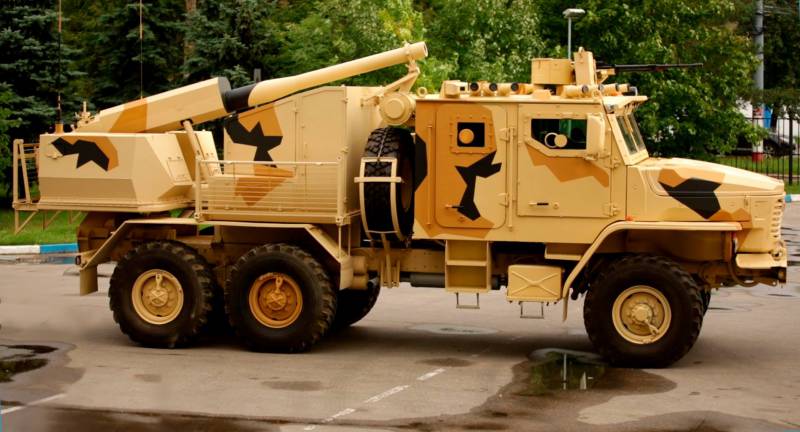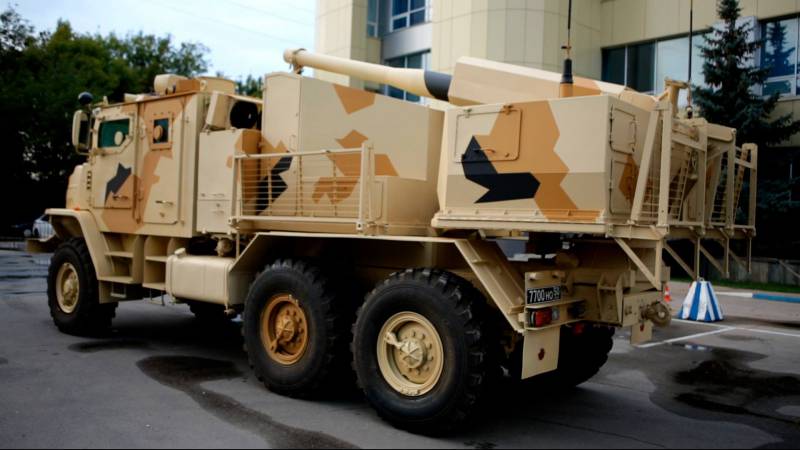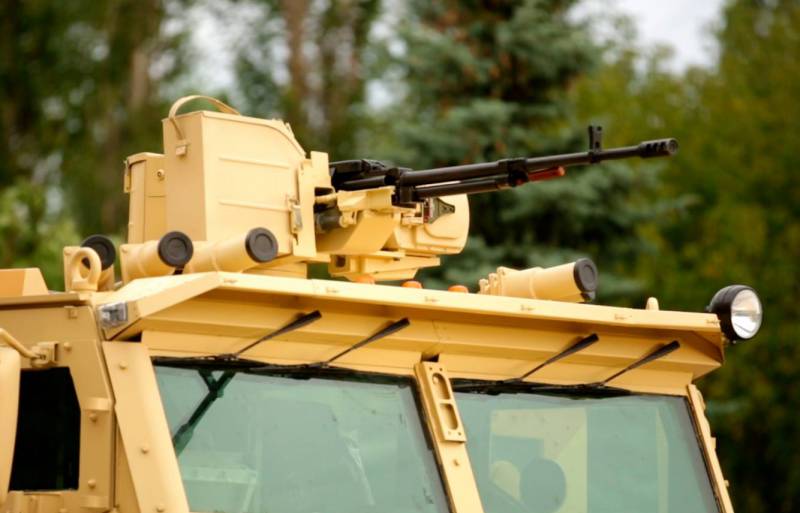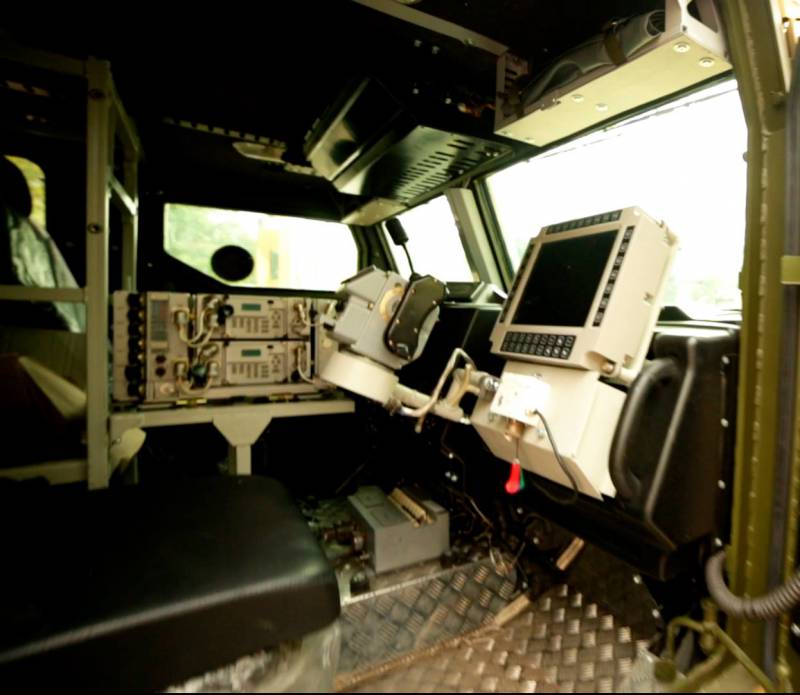The newest 120-mm self-propelled artillery gun "Phlox"
The existence of a promising CAO project called “Phlox” became known on August 30. On this day, the press service of the corporation "Uralvagonzavod" published a press release on the organization's participation in the upcoming exhibition "Army-2016". It was mentioned that more than fifty full-scale and mock-up samples of new systems, weapons and equipment will be shown at the exhibition site of the corporation. One of the exhibits, it was claimed, was to be the newest 120-mm self-propelled phlox artillery gun. Other details, however, were not reported.
The appearance of the self-propelled gun became known on the first day of autumn. On September 1, the State Secretary and Deputy General Director of the Uralvagonzavod Corporation, Alexey Zharich, on his page on the social network Facebook published several photos of the new development created by the specialists of the Central Research Institute Burevestnik. The posted pictures were jokingly called spy photos. On the same day, the Izvestia publication published excerpts from an interview with the director-general of the Petrel Research Institute (part of the Uralvagonzavod Corporation) Georgy Zakamennykh, who revealed some of the technical features of the new project.
Published a few days ago, information about the project of CJSC "Phlox" is not yet able to fully disclose all the features of the look of promising development. Nevertheless, the available amount of information allows us to consider the newest domestic combat vehicle, identify some of its features, as well as make certain assessments.
As follows from the existing photos, the project "Phlox" uses both existing and new components and assemblies. In particular, it is proposed to mount all the main components and armament of the vehicle on the basis of one of the existing wheeled chassis. With this approach, a successful combination of basic characteristics and ease of production can be ensured. Ultimately, this can have a noticeable impact on the commercial potential of the development.
The three-axle all-wheel drive chassis of the Ural-VV armored car is used as the basis for the IJSC Phlox. In its original form, the Ural-VV is an armored car designed for the transport of personnel or certain cargoes. The car is built on the bonnet layout and, as recent projects show, can be equipped with special equipment of the desired type. Under the hood of the car is a diesel engine YMZ-6565 270 horsepower. The transmission provides torque transmission to all six drive wheels.
Artillery self-propelled gun gets a cockpit, which is a shortened and revised version of the armored hull of the base machine "Ural-VV". This unit is a product of reduced length, providing double-row placement of the calculation. On the sides there are four doors necessary for access inside. Cabin receives armored glass. Glazing of doors is additionally equipped with loopholes. The cab hull characteristics have not yet been clarified, but there is reason to believe that the level of protection is similar to that of the base armored car. Recall, the Ural-BB car has 5 cab protection class with amplification up to 6 in some areas.
Behind the cockpit, after a short space, which is used to transport the spare wheel and accommodate some additional units, there are two blocks of targeted equipment. On the chassis frame, above the second axle, is placed the casing-box, designed to carry some payload. A characteristic feature of this unit is the sloping roof, due to the peculiarities of the artillery unit. On the front wall of the casing, there are fastenings to hold the gun barrel in the stowed position.
In the aft part of the chassis frame, the project of the CJSC “Phlox” provides for the installation of a turntable on which the artillery unit is located. In the central part of the rectangular platform, there are mechanisms for fastening and vertical guidance of the weapon. On the sides of them are covers, designed to accommodate some additional equipment. As can be seen in the existing images, the artillery part of the self-propelled gun has the possibility of horizontal and vertical guidance within fairly wide sectors. Guidance is carried out using automated mechanisms with remote control.
The main information about the gun used in the new self-propelled gun was announced by the general director of the Central Research Institute "Burevestnik" G. Zakamennykh. He said that a new artillery system was installed on the Phlox, partly based on existing units. According to ballistics and the shutter, the “Flox” gun is unified with the 2А80 system. At the same time, some new units were used. It is argued that with the help of new technical solutions, it was possible to increase the accuracy of shooting and reduce the load on the base chassis.
The gun has a barrel caliber 120 mm and is equipped with a combined semi-automatic shutter, the design of which is borrowed from an existing project. The project also provides recoil devices and fences. An important feature of the artillery part of the "Flox" is the use of automation that can monitor the position of the barrel. With its help, it is claimed that after each shot, it is possible to restore the previously established pickup, which has a positive effect on the accuracy and accuracy.
The ammunition of the self-propelled gun consists of 80 shots placed in several layouts. First of all it is proposed to use the so-called. operational styling that accommodates 28 shells. After this part of the ammunition is used up, the calculation may use ammunition from other stowages. Also, if necessary, it is possible to overload the ammunition from one stowage to another.
The types of ammunition proposed for use have not yet been clarified, but some assumptions can be made on this score. CJSC “Phlox” is equipped with a tool unified with the 2-80 system. Recall 120-mm gun 2А80 is used as part of self-propelled gun 2С31 "Vienna" and has a number of characteristic features. Due to some features of the design such a gun with a rifled barrel can be used as a howitzer-gun or mortar. Ammunition "Vienna" may include several types of shells, including controlled. It is also possible to use mortar mines of 120 caliber mm of any existing models, including foreign ones.
Taking into account the use of existing developments and the possible tactical niche proposed for CJSC Phlox, it can be assumed that in the case of a new project, it is again about the use of the original system with wide capabilities. If this is true, then the new self-propelled gun is able to use a variety of weapons with different characteristics. This feature greatly expands the range of combat missions.
All artillery systems must be controlled from a remote control installed in the cockpit. To control the operation of the system and the introduction of commands, it is proposed to use a unit incorporating a liquid-crystal monitor with a buttoned frame. Some other controls are also provided. Equipment for control of auxiliary armament is connected to the same console.
For self-defense and combat manpower or lightly armored equipment of the enemy, the crew of the Phlox self-propelled artillery gun must use a remote-controlled combat module. In preparation for the Army-2016 exhibition, the self-propelled gun prototype received a system with a Kord heavy machine gun. The module has systems for horizontal and vertical guidance, and is also equipped with mounts for the cartridge box and an optoelectronic unit. The module is connected to the control panel at the operator’s workplace. The crew member who manages the combat module has the ability to receive video from the optics of the module, as well as to fully control the operation of all mechanisms.
As an additional means of protection is proposed to use a set of smoke grenade launchers. These devices are mounted on the roof of the cabin in a fairly large number. Installation is carried out with a slight elevation angle. For setting the smoke screen in the front hemisphere it is proposed to use two sets of three grenade launchers. Two more of these sets are placed on the sides and are designed for firing forward and sideways. With the help of 12 smoke grenade launchers, the crew can carry out a disguise and it is relatively safe to escape from a collision with an enemy.
Another system designed to increase survivability in a combat situation is laser radiation detection equipment. Several units of such equipment are installed on the cab roof and, possibly, on some other units of the machine. The system of detection of laser irradiation allows you to timely notice the enemy preparing for the attack, and take the necessary measures.
To accommodate the crew on the march and during combat work is a protected cabin with a double row of seats. In front of her places are provided for the driver and gunner. Between them is placed a rack with some electronic equipment. The driver has a full set of controls to monitor the operation of all major chassis systems. The gunner, in turn, has a remote control artillery and machine gun armament. The rest of the crew are placed in the back row seats, behind the gunner and driver.
The Phlox project of self-propelled artillery guns has a number of characteristic features that are unusual for similar Russian-made equipment. Some of them, with certain reservations, even allow us to consider the Phlox project to be revolutionary new for Russian artillery systems. According to G. Zakamennykh, the placement of 120-mm artillery guns on the car chassis is a completely new solution for the domestic armed forces. In fact, this sample can be attributed to a completely new class of technology for our country. This new class allows you to significantly increase the mobility of artillery units. In addition, there are positive design features in the form of the maximum possible automation of the processes of preparing for firing and subsequent firing.
It is already clear that the original concept, implemented in the framework of the project of the CJSC "Phlox", allows to provide a sufficiently high firepower and improve the efficiency of combat work in solving various tasks. Depending on the type of target and other factors, the calculation of self-propelled guns can use ammunition of one type or another, the most appropriate to the existing situation. Artillery shells similar to those used by other guns can be used to attack targets with direct fire or for shooting at low angles of elevation. In other cases, 120-mm mines can be used that can "cover" trenches or other specific targets.
In the case of the SAO 2C31 "Vienna" gun, combining the qualities of a mortar and howitzer cannon, it is possible to use several dozen ammunition for different purposes with different characteristics. The maximum firing range can reach 8-10 km. In addition, some foreign active-missiles are capable of hitting targets at ranges up to 15-17 km. It can be assumed that the existing unification of the existing and prospective artillery system ensures the preservation of the main shooting parameters.
Let's summarize the preliminary results. The proposed concept, embodied in the metal in the form of the first prototype of the CJSC "Phlox", has some positive features, and can also demonstrate certain advantages over other techniques of a more familiar appearance. The wheeled chassis should provide high mobility and speed of transfer to new positions, as well as facilitate and simplify the operation of equipment. Maximum automation of the main processes of preparation for shooting and firing, in turn, allows us to simplify and speed up the basic processes of combat work, positively affecting the overall efficiency, as well as affecting survivability.
The idea of a weapon with advanced capabilities, combining the qualities of systems of several classes, has long been tested by practice and has interested the military. In addition, to date, this concept has been embodied in several projects self-propelled crawler. Now all the advantages of such tools are proposed to be combined with the positive features of the wheel chassis and modern control systems.
The result of the use of a number of interesting ideas and solutions not so long ago was the emergence of the Phlox self-propelled artillery gun. To date, the project has been brought to the construction of the sample, which in the next few days will have to be an exhibit of an exhibition of weapons and military equipment. In the future, work on the project should continue, which ultimately can lead to the emergence of contracts for the supply of promising technology to one or another customer, both domestic and foreign.
Domestic forces currently lack direct analogs of the Phlox CJSC, which have similar features, although there are several samples of tracked self-propelled guns with similar weapons. According to the results of tests and analysis of the possibilities, the new wheeled vehicle may suit the Russian military, which will result in the appearance of a contract for the supply of production vehicles. Also, the new development of the corporation "Uralvagonzavod" may be of interest to foreign customers. CJSC "Phlox" has a number of positive features, and also, apparently, does not differ in high cost. These features self-propelled guns may be of interest to foreign armies.
In the future, the Phlox self-propelled artillery gun can reach mass production in the interests of a particular customer. Nevertheless, such events should be expected no earlier than in a few months or even years. A matter of less distant perspective is the first public display of self-propelled guns. A platform for the “premiere” of promising development will be the Army-2016 forum. From 6 to 11 September, specialists and the general public will be able to familiarize themselves with the latest models of equipment and weapons of domestic development, including the IJSC “Phlox”.
On the materials of the sites:
http://uvz.ru/
https://facebook.com/alexey.zharich/
http://izvestia.ru/
http://bastion-opk.ru/
http://arms-expo.ru/




Information